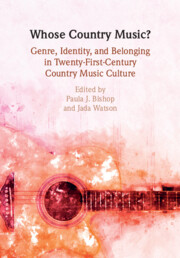Book contents
- Whose Country Music?
- Whose Country Music?
- Copyright page
- Contents
- Figures
- Tables
- Contributors
- “She went to Nashville to sing country music”
- Part I Industry
- 1 Mailbox Money
- 2 “Dixie Chicked”
- 3 How 360° Deals Homogenized Country Music
- 4 A Double-Edged Sword
- Part II Codes of Conduct
- Part III Authenticity
- Part IV Boundary Work
- Bibliography
- Index
1 - Mailbox Money
Novel Liberation Strategies of a Black Female Country Songwriter
from Part I - Industry
Published online by Cambridge University Press: 03 February 2023
- Whose Country Music?
- Whose Country Music?
- Copyright page
- Contents
- Figures
- Tables
- Contributors
- “She went to Nashville to sing country music”
- Part I Industry
- 1 Mailbox Money
- 2 “Dixie Chicked”
- 3 How 360° Deals Homogenized Country Music
- 4 A Double-Edged Sword
- Part II Codes of Conduct
- Part III Authenticity
- Part IV Boundary Work
- Bibliography
- Index
Summary
In 1983, a Black woman from Detroit, Michigan, Alice Randall, moved to Nashville determined to spotlight Black contributions to country music, become a novelist, and support herself by writing and publishing country songs. Forty years later, the company she founded and eventually sold, Midsummer Music continues to thrive. Randall, the only Black woman to co-write a song, “XXX’s and OOO’s (An American Girl),” that topped the country charts for two weeks running now teaches a course on Black Country at Vanderbilt University. Reflecting on four decades of navigating complex layers of sexism and racism; a business community that guarded itself against outsiders with a culture that included unique vocabulary, clothing, and calendar; and profound changes in how the country audience accesses music and pays for music, Randall offers a memoir of economic intention and ambition that makes visible the invisible work or certain Black women working on the row before her.
Keywords
- Type
- Chapter
- Information
- Whose Country Music?Genre, Identity, and Belonging in Twenty-First-Century Country Music Culture, pp. 13 - 26Publisher: Cambridge University PressPrint publication year: 2022

